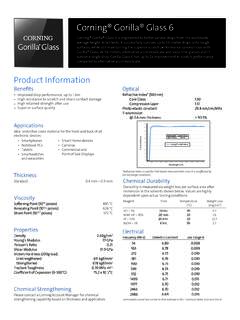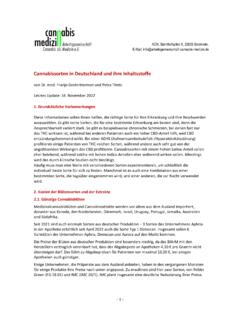Transcription of Phylogenetic Analysis Introduction to
1 Introduction to Phylogenetic AnalysisIrit OrrSubjects of this lecture1 Introducing some of the terminology some of the most commonlyused methods for Phylogenetic how to construct phylogenetictrees.]Taxonomy - is the science ofclassification of organisms.]Phylogeny - is the evolution of agenetically related group of organisms.]Or: a study of relationships betweencollection of "things" (genes, proteins, ) that are derived from a - WHY? Find evolutionary ties between organisms.(Analyze changes occuring in different organismsduring evolution).
2 Find (understand) relationships between anancestral sequence and it descendants.(Evolution of family of sequences) Estimate time of divergence between a group oforganisms that share a common tree Of LifeEukaryote treeEubacteria treeSimilar sequences, common common ancestor, similar functionFrom a common ancestor sequence, twoDNA sequences are of these two sequences start toaccumulate nucleotide number of these mutations are used inmolecular evolution we calculate theDegree of Divergence]If two sequences of length N differ fromeach other at n sites, then their degree ofdivergence is.
3 N/N or n/N*100%.Relationships of PhylogeneticAnalysis and Sequences AnalysisWhen 2 sequences found in 2 organisms arevery similar, we assume that they have derivedfrom one AAGAGTTAAGA(A/G)T(C/ T)The sequences alignment reveal which positions are conserved from the ancestor sequence. Relationships of PhylogeneticAnalysis and Sequences Analysis ]The progressive multiple alignment of a group ofsequences, first aligns the most similar pair.]Then it adds the more distant pairs.]The alignment is influenced by the mostsimilar pairs and arranged accordingly, not always correctly represent theevolutionary history of the occured changes.
4 ]Not all Phylogenetic methods work this of PhylogeneticAnalysis and Sequences Analysis ]Most Phylogenetic methods assume that eachposition in a sequence can changeindependently from the other positions.]Gaps in alignments represent mutations insequences such as: insertion, deletion, geneticrearrangments.]Gaps are treated in various ways by thephylogenetic methods. Most of them of PhylogeneticAnalysis and Sequences Analysis ]Another approach to treat gaps is by usingsequences similarity scores as the basefor the Phylogenetic Analysis , instead ofusing the alignment itself, and trying todecide what happened at each position.
5 ]The similarity scores based on scoringmatrices (with gaps scores) are used bythe DISTANCE is a Phylogenetic tree?]An illustration of the evolutionaryrelationships among a group of organisms.]Dendrogram is another name for aphylogenetic tree.]A tree is composed of nodes and branch connects any two adjacentnodes. Nodes represent the taxonomicunits. (sequences)What is a Phylogenetic tree? : 2 very similar sequences will beneighbors on the outer branches and will beconnected by a common internal of TreesNetworksOnly one path between any pair of nodesMore than one path between any pair of nodesseqAseqBseqCseqDLeaves = Outer branchesRepresent the taxa (sequences)123 Nodes = 1 2 3 Represent the relationships Among the taxa (sequences) Node 1 represent the ancestor seq from which seqA and seqB derived.
6 **Branches *The length of the branch represent the # of changes that occurred in theseqs prior to the next level of Phylogenetic TreeEDCBAFHIGE xternal branches - are branches that end with a tip. (FA,FB,GC,GD,IE) more recent diversionsInternal branches - arebranches that do not endwith a tip.(IH,HF,HG) more ancient diversionsIn a Phylogenetic NODE represents a speciation event inevolution. Beyond this point any sequencechanges that occurred are specific for eachbranch (specie).9 The BRANCH connects 2 NODES of the length of each BRANCH between oneNODE to the next, represents the # of changesthat occurred until the next separation(speciation).
7 In a Phylogenetic : The amount of evolutionary time thatpassed from the separation of the 2 sequencesis not known. The Phylogenetic Analysis can onlyestimate the # of changes that occurred from thetime of the branching event, one taxon (sequence)can undergo more mutations then the of a tree is the branching pattern of structure Terminal nodes - represent the data ( ) under comparison(A,B,C,D,E), also known as OTUs,(Operational Taxonomic Units). Internal nodes - represent inferredancestral units (usually without empiricaldata), also known as HTUs, (HypotheticalTaxonomic Units).
8 Slide taken from Dr. Itai YanaiDifferent kinds of trees can be used to depict different aspects of evolutionary history1. Cladogram: simply shows relative recency of common ancestry2. Additive trees: a cladogram with branch lengths, also called phylograms and metric trees3. Ultrametric trees: (dendograms) special kind of additive tree in which the tips of the trees are all equidistant from the root5431373211111231113 The Molecular Clock Hypothesis]All the mutations occur in the same rate in allthe tree branches.]The rate of the mutations is the same for allpositions along the sequence.
9 ]The Molecular Clock Hypothesis is most suitable forclosely related Tree = Cladogram]A Phylogenetic tree thatall the "objects" on itshare a known commonancestor (the root).]There exists a particularroot node.]The paths from the rootto the nodescorrespond toevolutionary Phylogenetic tree where allthe "objects" on it are relateddescendants - but there isnot enough information tospecify the commonancestor (root).]The path between nodes ofthe tree do not specify anevolutionary Tree = PhenogramSlide taken from Dr. Itai YanaiTypes of TreesRooted vs.
10 Unrooted2M 32M 22M 12M 2 TotalUnrootedTotalRootedM 2M 3 InteriorM 1M 2 InteriorNodesBranchesM is the number of OTU sRooted versus Unrooted The number of tree topologies of rootedtree is much higher than that of theunrooted tree for the same number ofOTUs. Therefore, the error of the unrooted treetopology is smaller than that of the Number ofRooted treesUnrootedtrees2113314153510515694510 5710395945813513510395920270251351351034 4594252027025 The number of rooted and unrooted trees:Number of OTU sOTU Operational Taxonomical UnitSlide taken from Dr.





